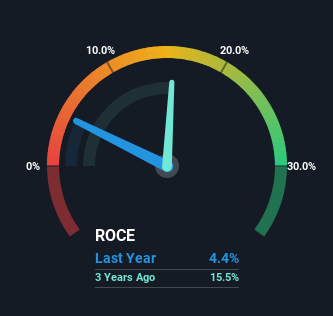- China
- /
- Electronic Equipment and Components
- /
- SHSE:688539
Returns On Capital At NanJing GOVA Technology (SHSE:688539) Paint A Concerning Picture
If you're looking for a multi-bagger, there's a few things to keep an eye out for. Typically, we'll want to notice a trend of growing return on capital employed (ROCE) and alongside that, an expanding base of capital employed. Basically this means that a company has profitable initiatives that it can continue to reinvest in, which is a trait of a compounding machine. However, after investigating NanJing GOVA Technology (SHSE:688539), we don't think it's current trends fit the mold of a multi-bagger.
Return On Capital Employed (ROCE): What Is It?
For those that aren't sure what ROCE is, it measures the amount of pre-tax profits a company can generate from the capital employed in its business. The formula for this calculation on NanJing GOVA Technology is:
Return on Capital Employed = Earnings Before Interest and Tax (EBIT) ÷ (Total Assets - Current Liabilities)
0.044 = CN¥80m ÷ (CN¥1.9b - CN¥118m) (Based on the trailing twelve months to March 2024).
Therefore, NanJing GOVA Technology has an ROCE of 4.4%. In absolute terms, that's a low return but it's around the Electronic industry average of 5.2%.
See our latest analysis for NanJing GOVA Technology

Above you can see how the current ROCE for NanJing GOVA Technology compares to its prior returns on capital, but there's only so much you can tell from the past. If you'd like, you can check out the forecasts from the analysts covering NanJing GOVA Technology for free.
So How Is NanJing GOVA Technology's ROCE Trending?
When we looked at the ROCE trend at NanJing GOVA Technology, we didn't gain much confidence. Over the last five years, returns on capital have decreased to 4.4% from 16% five years ago. However, given capital employed and revenue have both increased it appears that the business is currently pursuing growth, at the consequence of short term returns. If these investments prove successful, this can bode very well for long term stock performance.
On a side note, NanJing GOVA Technology has done well to pay down its current liabilities to 6.1% of total assets. So we could link some of this to the decrease in ROCE. What's more, this can reduce some aspects of risk to the business because now the company's suppliers or short-term creditors are funding less of its operations. Since the business is basically funding more of its operations with it's own money, you could argue this has made the business less efficient at generating ROCE.
The Bottom Line
Even though returns on capital have fallen in the short term, we find it promising that revenue and capital employed have both increased for NanJing GOVA Technology. And there could be an opportunity here if other metrics look good too, because the stock has declined 17% in the last year. As a result, we'd recommend researching this stock further to uncover what other fundamentals of the business can show us.
Since virtually every company faces some risks, it's worth knowing what they are, and we've spotted 2 warning signs for NanJing GOVA Technology (of which 1 is a bit concerning!) that you should know about.
While NanJing GOVA Technology isn't earning the highest return, check out this free list of companies that are earning high returns on equity with solid balance sheets.
Valuation is complex, but we're here to simplify it.
Discover if NanJing GOVA Technology might be undervalued or overvalued with our detailed analysis, featuring fair value estimates, potential risks, dividends, insider trades, and its financial condition.
Access Free AnalysisHave feedback on this article? Concerned about the content? Get in touch with us directly. Alternatively, email editorial-team (at) simplywallst.com.
This article by Simply Wall St is general in nature. We provide commentary based on historical data and analyst forecasts only using an unbiased methodology and our articles are not intended to be financial advice. It does not constitute a recommendation to buy or sell any stock, and does not take account of your objectives, or your financial situation. We aim to bring you long-term focused analysis driven by fundamental data. Note that our analysis may not factor in the latest price-sensitive company announcements or qualitative material. Simply Wall St has no position in any stocks mentioned.
Have feedback on this article? Concerned about the content? Get in touch with us directly. Alternatively, email editorial-team@simplywallst.com
About SHSE:688539
NanJing GOVA Technology
Engages in the research, design, development, production, and sale of sensors and sensor network systems in China.
Flawless balance sheet with reasonable growth potential.
Market Insights
Community Narratives


Recently Updated Narratives


MINISO's fair value is projected at 26.69 with an anticipated PE ratio shift of 20x


Fiverr International will transform the freelance industry with AI-powered growth

Constellation Energy Dividends and Growth
Popular Narratives


MicroVision will explode future revenue by 380.37% with a vision towards success


NVDA: Expanding AI Demand Will Drive Major Data Center Investments Through 2026



